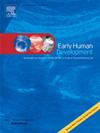Antenatal corticosteroid exposure and neonatal outcomes in term infants
IF 2.2
3区 医学
Q2 OBSTETRICS & GYNECOLOGY
引用次数: 0
Abstract
Background
Antenatal corticosteroids (ACS) are widely used to mitigate respiratory distress in preterm infants. Although the benefits of ACS in preterm births are well established, less is known about the short-term neonatal risks when ACS is administered during pregnancies that result in term delivery. Additionally, the impact of gestational age at the time of ACS exposure in this population remains unclear.
Aim
To evaluate the association between ACS exposure and short-term neonatal outcomes in term-born singleton infants, and further assess outcome variation by gestational age at exposure.
Method
This retrospective, population-based cohort study used data from the Taiwan Maternal and Child Health Database and the National Health Insurance Research Database to compare term-born singleton infants exposed to ACS for threatened preterm labor with those unexposed, whose mothers had no diagnosis of preterm labor and no recorded ACS administration. Neonatal outcomes were analyzed using multivariable logistic regression.
Results
Among 800,024 term births, 5577 (0.6 %) were exposed to ACS due to preterm labor. ACS-exposed infants had higher rates of SGA, CPAP, oxygen use, NICU admission, sepsis, hypoglycemia, TTNB, and jaundice (P < 0.001). Adjusted analyses revealed higher odds of SGA (aOR 1.30; 95 % CI 1.20–1.41), NICU admission (aOR 1.16; 95 % CI 0.99–1.36), and hyperbilirubinemia (aOR 1.49; 95 % CI 1.38–1.61) in the exposed group. Exposure between 28 and 33 weeks was associated with increased odds of oxygen therapy (aOR 1.42; 95 % CI 1.21–1.67) and TTNB (aOR 1.40; 95 % CI 1.00–1.94).
Conclusion
ACS exposure is associated with increased risks of short-term neonatal complications among term-born infants, especially when exposure between 28 and 33 weeks' gestation. Even when pregnancies end in term delivery, ACS exposure may still increase neonatal morbidity risk.
足月婴儿产前皮质类固醇暴露与新生儿结局
背景:产前皮质类固醇(ACS)被广泛用于减轻早产儿呼吸窘迫。虽然ACS对早产儿的益处已经得到了很好的证实,但对于在怀孕期间使用ACS导致足月分娩的短期新生儿风险知之甚少。此外,该人群暴露于ACS时胎龄的影响仍不清楚。目的评估ACS暴露与足月单胎婴儿短期新生儿结局的关系,并进一步评估暴露时胎龄对结局的影响。方法本研究采用台湾母婴健康数据库和国民健康保险研究数据库的数据,回顾性、以人群为基础的队列研究,比较因先兆早产而暴露于ACS的足月单胎婴儿与未暴露于ACS的母亲未诊断出早产且未记录ACS用药的单胎婴儿。采用多变量logistic回归分析新生儿结局。结果80万24例足月新生儿中,5577例(0.6%)因早产暴露于ACS。暴露于acs的婴儿SGA、CPAP、吸氧、NICU入院、败血症、低血糖、TTNB和黄疸的发生率较高(P <;0.001)。调整后的分析显示SGA的几率更高(aOR 1.30;95% CI 1.20-1.41),新生儿重症监护病房入院(aOR 1.16;95% CI 0.99-1.36)和高胆红素血症(aOR 1.49;95% CI 1.38-1.61)。暴露于28 - 33周与氧治疗的几率增加相关(aOR 1.42;95% CI 1.21-1.67)和TTNB (aOR 1.40;95% ci 1.00-1.94)。结论:acs暴露与足月婴儿短期新生儿并发症风险增加有关,特别是在妊娠28 ~ 33周暴露时。即使妊娠终止足月分娩,暴露于ACS仍可能增加新生儿发病风险。
本文章由计算机程序翻译,如有差异,请以英文原文为准。
求助全文
约1分钟内获得全文
求助全文
来源期刊

Early human development
医学-妇产科学
CiteScore
4.40
自引率
4.00%
发文量
100
审稿时长
46 days
期刊介绍:
Established as an authoritative, highly cited voice on early human development, Early Human Development provides a unique opportunity for researchers and clinicians to bridge the communication gap between disciplines. Creating a forum for the productive exchange of ideas concerning early human growth and development, the journal publishes original research and clinical papers with particular emphasis on the continuum between fetal life and the perinatal period; aspects of postnatal growth influenced by early events; and the safeguarding of the quality of human survival.
The first comprehensive and interdisciplinary journal in this area of growing importance, Early Human Development offers pertinent contributions to the following subject areas:
Fetology; perinatology; pediatrics; growth and development; obstetrics; reproduction and fertility; epidemiology; behavioural sciences; nutrition and metabolism; teratology; neurology; brain biology; developmental psychology and screening.
 求助内容:
求助内容: 应助结果提醒方式:
应助结果提醒方式:


